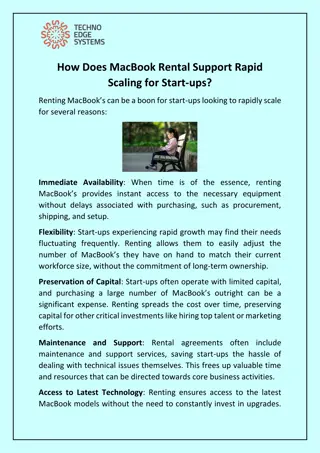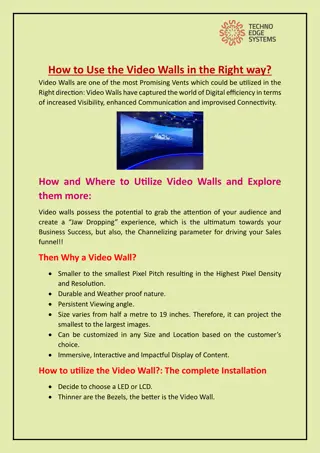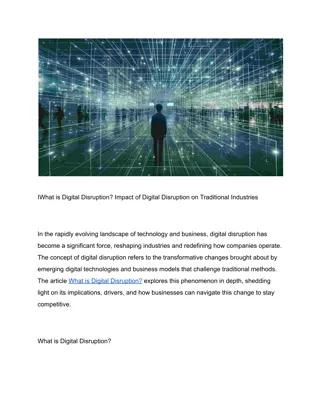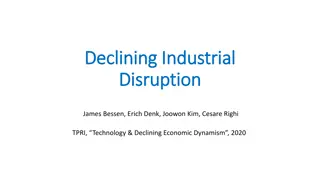Disruption and Downfall of Blockbuster in the Video Rental Industry
Blockbuster, once a market leader in video rentals, faced disruption due to technological advancements and changing consumer habits. Netflix emerged as a small tech startup that revolutionized the industry with streaming services, leading to Blockbuster's downfall. The evolution from VHS to DVD, rise in home computer ownership, and internet access were key factors contributing to this disruption.
Download Presentation

Please find below an Image/Link to download the presentation.
The content on the website is provided AS IS for your information and personal use only. It may not be sold, licensed, or shared on other websites without obtaining consent from the author.If you encounter any issues during the download, it is possible that the publisher has removed the file from their server.
You are allowed to download the files provided on this website for personal or commercial use, subject to the condition that they are used lawfully. All files are the property of their respective owners.
The content on the website is provided AS IS for your information and personal use only. It may not be sold, licensed, or shared on other websites without obtaining consent from the author.
E N D
Presentation Transcript
Blockbuster: Going for Broke HEC Montreal CSC Consulting Olivier Cohen, Brandon Jacobs, Jessica Drolet, Richard Wallace
Introduction Analysis Strategy Conclusion Blockbuster Company Background Video renting company with largest North American market share until early 2000 s Operated brick and mortar locations throughout North America Market leader One at every corner
Introduction Analysis Strategy Conclusion Blockbuster Company Background Purchased licenses to distribute Carried large selection of films including all new releases Operational costs of carrying and maintaining media Replacement costs during technological changes (VHS to DVD) Diversified into game console rentals and video game rentals Large customer base and retention
Introduction Analysis Strategy Conclusion Blockbuster and the Video Rental Industry Excellent example of global disruption due to: Disruption Technological change (DVD, Internet age) Consumer habit change Driving An industry forever changed by Netflix and streaming services Small tech startup (Netflix) Blockbuster Disrupt
Introduction Analysis Strategy Conclusion Blockbuster and the Video Rental Industry Excellent example of global disruption due to: Disruption Technological Change (DVD, Internet age) Consumer habit change Driving An industry forever changed by Netflix and streaming services Blockbuster X Small Tech Startups (Netflix)
Introduction Analysis Strategy Conclusion Three stages of disruption From VHS to DVD Impact Vending machines, subscription, catalogue (Netflix) Disturb Streaming services: HULU, CraveTV, Netflix, HBO, BBC, etc. Disrupt A cost-intensive model that could not evolve fast enough
Introduction Analysis Strategy Conclusion Root causes of this disruption Rise in home computer ownership (Apple/PC) Internet access Tech-savvy generation Changing consumer habits
Introduction Analysis Strategy Conclusion Key Issues for Blockbuster 1. What could have Blockbuster done with its assets? 2. How could they have competed in the digital age? 3. How could they have locked out competition?
Introduction Analysis Strategy Conclusion Alternatives Acquisition of disruptors Organic Adaptation Industry Exit Buy subscription model competitors Develop internal subscription model Foster a comparable BLOCKFLIX Leverage size to kill competition Divest less profitable locations over time Divest assets Maintain Bricks & Mortars Try to purchase Netflix
Introduction Analysis Strategy Conclusion Decision Criteria 1. Stays on-trend with new technological trends 2. Leverages changing consumer habits 3. Leverages existing know-how and competitive advantage
Introduction Analysis Strategy Conclusion Decision Criteria Alternative On-trend with new Tech. Leverages changing consumer habits Leverages existing know-how and competitive adv. 1. Acquisition of disruptors 2 1 1 2. Organic Adaptation 4 4 4 3. Industry Exit 1 1 1 1: Low 4: High
Introduction Analysis Strategy Conclusion Decision Criteria Alternative On-trend with new Tech. Leverages changing consumer habits Leverages existing know-how and competitive adv. 1. Acquisition of disruptors 2 1 1 2. Organic Adaptation 4 4 4 3. Industry Exit 1 1 1 1: Low 4: High
Introduction Analysis Strategy Conclusion Organic Growth Strategy Late 90 s Develop vending machine / catalogue / subscription distribution model Reduce reliance on capital-intensive brick and mortar Expands reach and adapts to changing consumer habits Diversify product mix at brick-and-mortar locations
Introduction Analysis Strategy Conclusion Organic Growth Strategy Early to mid 2000 s Develop and launch streaming service on-trend with digital distribution Leverage size, client relationships, brand strength to lockout competition Exclusivity agreements Buyback of valuable brick and mortar locations to build real-estate portfolio Rent to retailers Buyback from franchisees Divest low-value assets
Introduction Analysis Strategy Conclusion The failure of status quo Rise of subscription + catalogue rental options in the 90 s No response from Blockbuster = missed opportunity to adapt to new distribution model Management failure to monitor industry context, consumer trends Introduction of digital streaming from early 2000 s Brick and mortar becoming less popular Continued reliance on obsolete technology (DVD) Minor sales strategies far too little, too late
Introduction Analysis Strategy Conclusion The failure of status quo Judgement: An established player refusing to react False belief in safety through their size and reach Failure to appreciate the potential lethality of the threat A complete strategic failure: oCapital intensive company oCouldn t affordably keep pace with innovation oHesitation killed the company
Introduction Analysis Strategy Conclusion Retrospective Blockbuster was a market leader entering the digital age but did not keep up with emerging trends Business model disrupted due to technological shifts and changing consumer habits Numerous paths to survival were possible but none effectively implemented Potential successful avenue: migrate business online and sell off assets. Similar industry: news corporations (newspapers).























